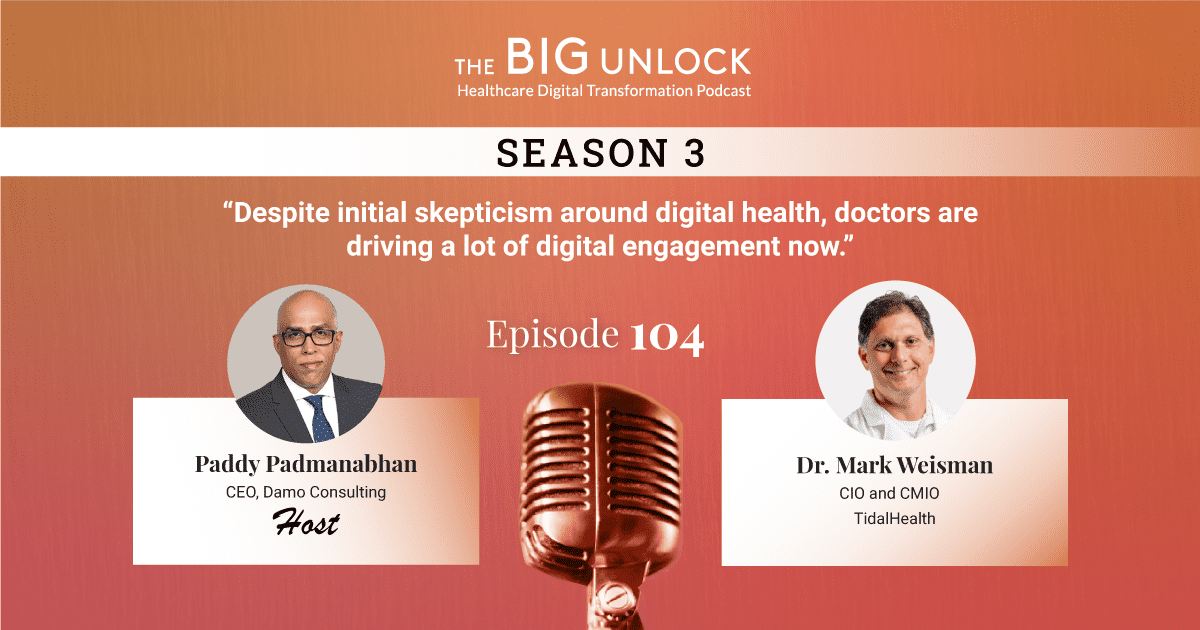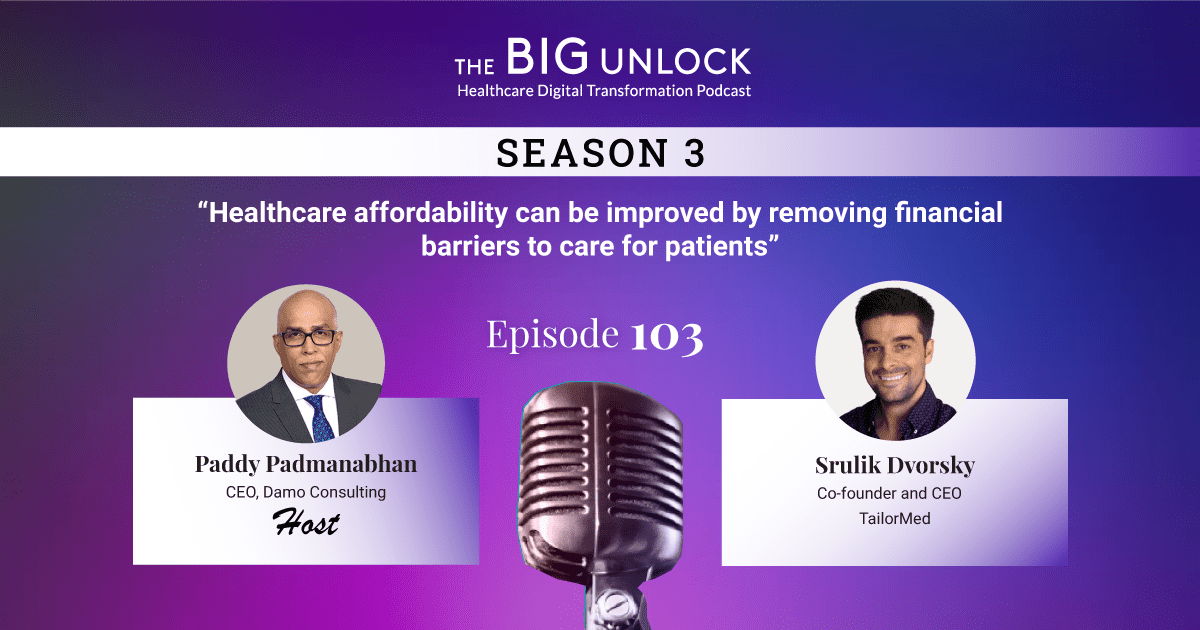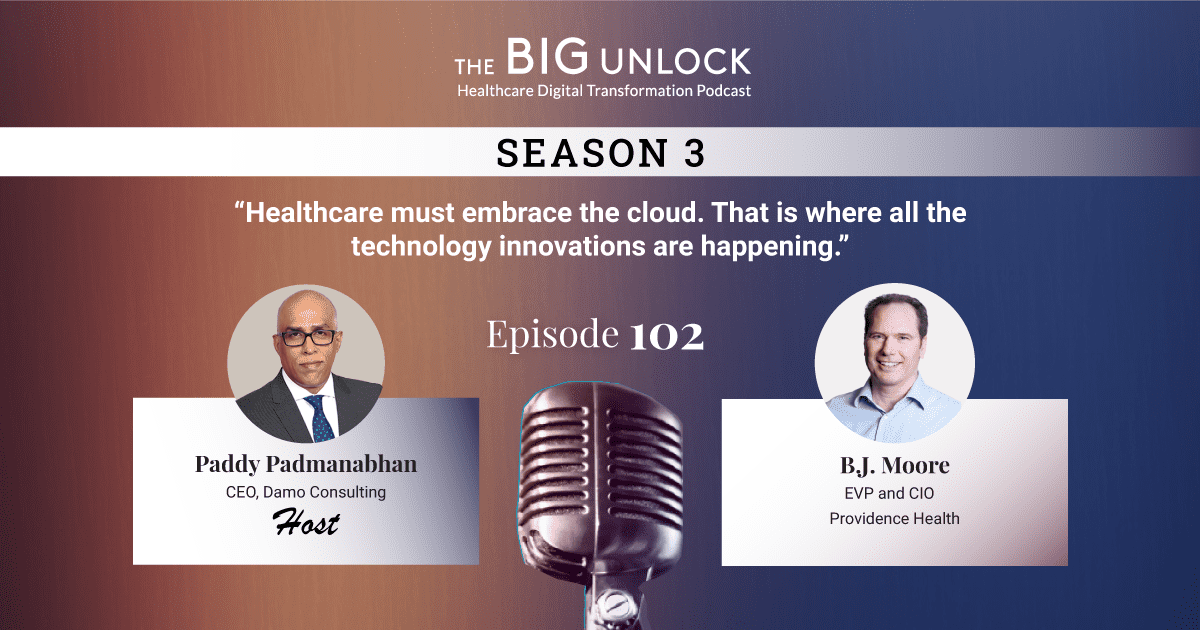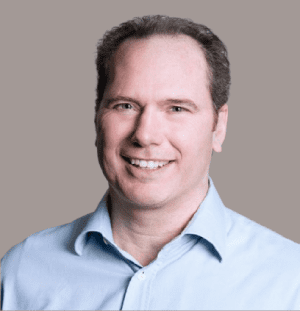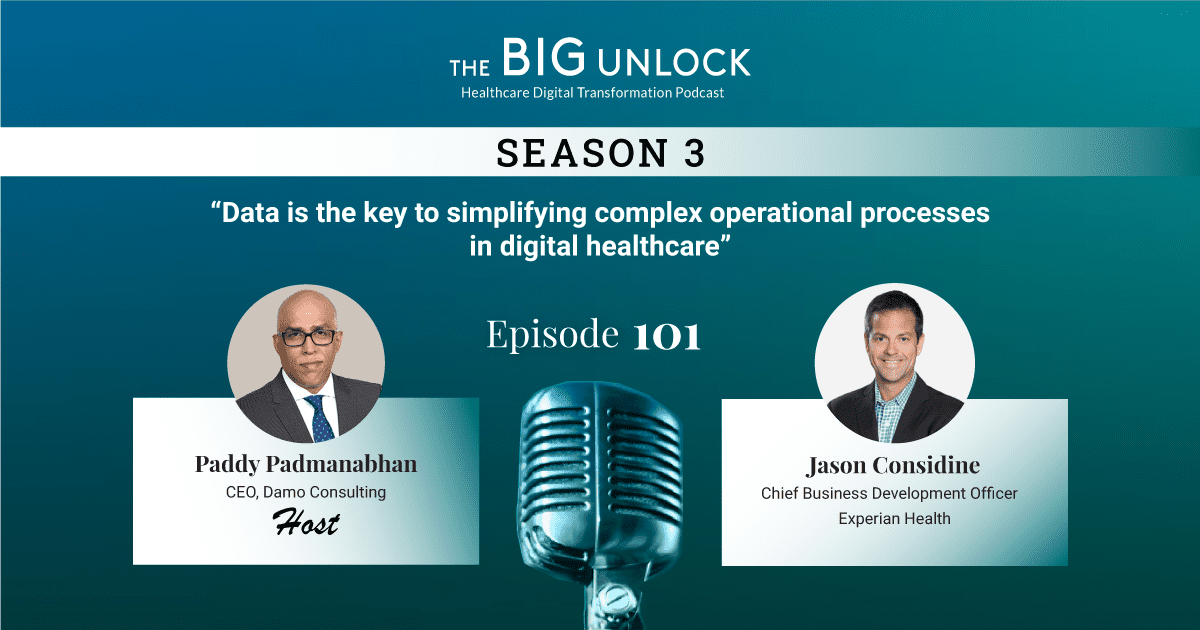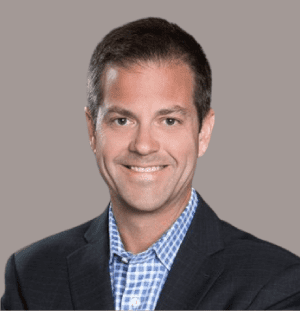Season 3: Episode #104
Podcast with Dr. Mark Weisman, CIO and CMIO, TidalHealth
“Despite initial skepticism around digital health, doctors are driving a lot of digital engagement now.”
 Hosted by Paddy Padmanabhan
Hosted by Paddy Padmanabhan 
Share
In this podcast, Dr. Mark Weisman, CIO and CMIO of TidalHealth, Maryland, discusses the role of analytics and informatics in identifying bottlenecks and the opportunities where technology may be harnessed to enhance the quality of care. Tidal Health is a two-hospital health system on the eastern shore of Maryland, serving largely the rural population of Delmarva Peninsula.
As a physician who’s well versed with emerging technologies, Dr. Weisman acknowledges the handicaps digital health care must overcome to reach the underserved population in rural America. The foremost focus of their digital journey is to improve patient access to healthcare. He demonstrates how certain digital health tools can bring in cost-effectiveness, reduce the administrative workload on clinical staff, develop effective programs, and provide better healthcare access to everyone.
Dr. Weisman advises digital health start-ups to approach health systems and healthcare as genuine partners in improving patient access and care delivery and not as a salesman merely trying to sell a product or service. Take a listen.
Show Notes |
||||
| 01:15 | About Tidal Health, your role, and responsibilities | |||
| 03:49 | What are your top priorities right now? | |||
| 05:44 | Access and digital health go together. What are you doing in that space? | |||
| 07:51 | How have the physicians responded to digital engagement? | |||
| 09:24 | You largely serve the rural populations. Does that have any kind of a bearing on your adoption rates, for instance, for digital health tools? | |||
| 11:20 | How are you bringing the two words – data and analytics – together to really use data analytics capabilities to drive digital engagement? | |||
| 13:23 | How you go through the thought process of evaluating and picking vendors that you want to talk to? | |||
| 14:54 | Do you go with an EHR-first strategy when it comes to turning-on your capability? How do you see your vendors coming along when it comes to these kinds of newer capabilities? | |||
| 16:38 | What is your advice to startups or healthcare companies who want to contact you? | |||
About our guest
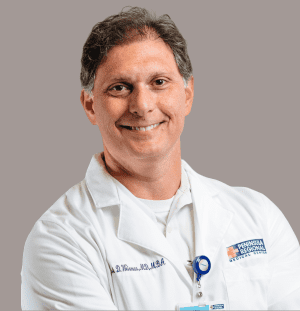
Dr. Mark Weisman is the Chief Information Officer / Chief Medical Information Officer for TidalHealth, Inc. He is a board-certified Internal Medicine and Informatics physician, who has practiced in inpatient and ambulatory care settings in hospitals, high-volume clinics, and retainer-style clinics. As an executive leader CIO and CMIO, he drives technology changes to make the lives of our practicing clinicians better. He is responsible for improving the cybersecurity posture of the organization, creating transparency into IT project activity, and improving IT agility.
Q. Tell us about Tidal Health, your role, and responsibilities.
Mark: Tidal Health is two-hospital health system on the eastern shore of Maryland. We tend to be fairly rural as we’re growing as a health system. Currently, roughly 400 beds at Tidal Health are filled up with COVID patients like everyone else. We continue to acquire practices which are coming to us looking for help because of some of the financial pressures in the market now, so, we’re definitely busy. I became CIO in August. I was the CMIO here for about three years, and it’s been a very interesting couple of months since becoming the CIO. There’s plenty of work to do.
Q: How did being a CMIO prepare you for this role, if at all?
Mark: It did help. My initial focus as a CMIO was on making the lives of the doctors better. That grew into helping the nurse practitioners, the nurses, the physical therapists and really making the EHR easier for a lot of people. It was exciting, fun and people really enjoyed that but there’s a lot left to be done. While we’re not perfect, we’re certainly becoming better.
When the opportunity came up for me to lead the EPIC application team — that was about half of our team and the number of analysts is just unbelievable — we had a good team, and we did some great things. That’s how I got the CIO role. While I still have the CMIO role and I do both, the challenges became clear soon. Already being the CMIO, I realized there was some tech part to becoming the CIO that I had to get up to speed on very quickly. I got the EPIC, the medical part, and the operations part.
Q: You’re a physician and have been involved in tech. What are your top priorities right now?
Mark: The organization is in pretty good shape in terms of infrastructure, so, I get to focus on some of the more fun things though we do have some challenges around access and provisioning — pain points for operations. Every time someone new comes into the organization, we can’t seem to get their access right on their first shift and it’s not good. So, they can’t get in nor see what they have to see. We need to take out the people who have been with our organization for years and not offer them access anymore. I really want to improve that because that goes along with my initial launch of making the EHR better for everyone. While this is just a piece of the entire job, it’s an important one. That’s a focus area plus there are other security issues, though we’re not in bad shape there.
Playing around in the automation space has been the most exciting part that’s energized me. I’m helping others be more efficient. However, it’s in finance that I’ve never had the opportunity to help out. It could be something like scanning of papers for HIM but we’re going to look at automating that with some new technology. What’s cool about being the CIO is that I get to do more.
Q: Access and digital health go hand-in-hand. What are you doing in that space?
Mark: Our digital journey started with EPIC. While we had a portal, there wasn’t anything really exciting there so no one really went to it. In November 2019, after a discussion with our executive leadership, we decided to put all our notes and labs out there to give people a reason to go to the patient portal. And that’s how it started. One of the decisions that was made at that time was around telehealth. That wasn’t on our roadmap then, and we weren’t going to do it. We were going to focus on some other pieces of the digital experience.
But there was a little change in plans. So, eventually we went with telehealth via Zoom and introduced a little more of digital health patient engagement. Our weak point was, however, around appointment reminders since it was being undertaken by the front desk — picking up the phone, dialing, getting the next person, leaving a message — and not very modern. I proposed a solution.
We began using Phreesia by which a text message to schedule appointments would be sent out and the frequencies of these messages and their times could be controlled by us. Our aim was to free up the front desk staff so they could be more efficient. We found that previously, our front desk staff were reaching out to over 50% of the patients but their no-show rates were high, and they never took breaks. Now those numbers were far lower, and we could see immediate results.
Our digital journey right now has entailed getting to that point of better access. Though our appointment scheduling is still via the portal, there’s more to the digital experience offered there.
Q: And how have the physicians responded to digital health patient engagement?
Mark: They fought it tooth and nail when it came to certain parts such as, releasing all labs in real-time, releasing pathology though when we did that, I got just one phone call in six months. There are many who must have had questions or concerns, but it became easier when the government enforced it. That did help with some buying acceptance.
The doctors were initially a little skeptical about telehealth. Then, there were the early adopters who jumped on it during the pandemic and did very well. They just went out and got their own tools and started doing telehealth because they wanted to see their patients. I thought it was great. I’m waiting for our tools now.
However, we’re seeing a lot less — under 10% — maybe 4-6% of our visits now are going by telehealth. The doctors are driving a lot of that; we must not underestimate how resilient healthcare can be to change. The doctors like seeing people in-person, where things are built around them rather than their patients. Healthcare will go back to the way it always was without some other mandate pushing it along.
Q: What about the patients themselves? You mentioned that you were largely rural? Does that have any kind of a bearing on your adoption rates, for instance, for digital health tools?
Mark: It does. When the pandemic began, we suffered with broadband congestion and poor connectivity. The final mile killed us, and we were facing 20% failure rates on video calls. We faced inability to establish the connection, or the patient didn’t know what to do – either way, the technology wasn’t easy, or they just didn’t have the bandwidth, and they became very frustrated.
That has played a big role for all healthcare in America, so we aren’t unique in this regard. We do not have broadband connections across our population neither do we have great cell signal. Some parts of our population are really isolated and that tends to be the segment that needs most care — the underserved with a lot of both, physical and mental health issues.
That segment would really benefit from this. We’ve tried to speak with the carriers — Verizon — and they’re like, we have the best coverage in the country. I get that. But in this little world, we need help. It’s just not realistic until the government coughs up the billions of dollars it’s going to take to get broadband everywhere it needs to be. Till then the rural areas will be struggling.
Q: It looks like the pandemic accelerated the shift towards digital, in a positive way and the early signs are great! It was all about data analytics. How are you bringing these two worlds together to really use data analytics capabilities to drive digital health patient engagement?
Mark: I got into data because I always wanted to win the arguments. The one with the data wins the arguments, so that still applies. When I present to the doctors, I show them the number of patients who are self-scheduling now, and the numbers are going up. The doctors are getting used to that but then, some do say that the patients scheduled in the wrong time slot. This happens all the time.
So, we have to check and see how frequently this happened and once the data is communicated, I don’t hear from them again. So, data will really help drive doctors when they go with the “it always happens or it’s never good” argument. We’re able to show that more patients are checking in online, switching appointments, finding their doctors and that data speaks to me, enough to help convince some of our executives, not just doctors.
Why are we investing in this? Why do we need our website to be something that brings in patients? Well, patients know how to find us for it’s a rural area and where else would they go? They want to connect to us through our website. So, we’re working on it.
Q: You mentioned a couple of partnerships that you have entered into to drive some of your digital initiatives, but the market is flooded with innovative solutions. How do you keep yourself abreast of what’s working and pick vendors you want to talk to?
Mark: It comes a lot from colleagues and via recommendations. I’m still a part of the CMIO forums. So, I’ll ask questions there and get some recommendations, periodically.
I went to CHIME for the first time and had a wonderful experience interacting with other CIOs. I found a whole bunch of other physician-CMIOs, which was very helpful because they’d walked in these shoes, so they knew some of the other technologies that I’d read about and heard of on other podcasts.
There’s no magic answer or one way to stay abreast of this stuff. There are so many vendors, it’s overwhelming and there’s a lot of overlap. Sometimes it’s hard to differentiate one from the other. The price obviously speaks volumes in these kinds of times. And for us, our budget has just been slashed. All the money goes to finding good nurses since they’re what we need right now. So, the vendors that can help us with that problem are very helpful for us.
Q: Do you go with an EHR-first strategy when it comes to turning-on your capability? How do you see them coming along when it comes to these kinds of newer capabilities?
Mark: That’s an interesting question. The EPIC App Orchard is a tool that I would use to locate new vendors because I know certain hurdles have already been covered, so I don’t really have to introduce this vendor to EPIC. In fact, they can start working out that partnership directly. It also means they probably have hit a certain level of maturity because they’re not getting into the EPIC App store without some basic security in place. So, there is some comfort to that. It’s also somewhat limiting. I’m not sure we get all the best vendors that we could ever want by only looking in the App Orchard. Certainly, there’s that bit on interoperability and integration.
I also don’t want people to say that going via a portal implies being out of their workflow. So, if we’re talking about a tool that is for clinicians, yes, I’m going to go EHR-first. If it’s finance there, they don’t really care because they want the best solution.
I’d also like to get some unified solutions for we have a ton of little silos, and it’s very difficult to understand how to run a business without the data even being able to flow back and forth or to see the impact when the census went up. So, how many nurses do we need? How many nurses do we have? How many are on standby? Without all those pieces connecting, it’s very different.
Q: What is your advice to startups or healthcare companies who want to contact you? Do you tell them to get certified on App Orchard first?
Mark: At CHIME, the vendors were certainly there, they were engaging though they were not overly sales-oriented. That’s their business so they’re there. But the ones I liked to connect with, were the ones who came with genuine partnership. They’re not there to sell you. Though I have heard from others, this is a real vendor connection.
There was one vendor who I’m very interested in working with their consulting firm and they have people on their staff who do nothing but work as technology advisors. They’re not selling anything but are around to help. They have a sales arm and other pieces that point to what they do and while I’m intrigued by this, it’s a sign of partnership. And there’s no charge on me calling them up or picking their brain. That’s helpful. Maybe they can guide me through some things or towards solutions that they’ve seen work for others.
Q: I must ask you about your podcast, now. You’ve been one of my favorite podcasters, and I’ve had the honor of being on your podcast as well. So, now that you’re CIO, do you have time for the podcast and will you be doing more? Where’s that headed?
Mark: Doing a podcast is a ton of fun. It was awesome at educating me and I learnt what others were doing. I also made connections — many of those I interviewed, I did run into over the last two or three weeks at Chime. That was fantastic.
Time is a challenge now that I’m both, the CIO and the CMIO, so I have been a delinquent. As my listeners would know, I haven’t put out content in quite some time. But there were some people who I ran into who wanted me to do some things and get back on air. And I would like to do that. So, it’s not dead; just on a little pause till such time as I get the team together and get things how I’d like to have them and convince the leadership that we’re stable and everything’s going to be fine.
We hope you enjoyed this podcast. Subscribe to our podcast series at www.thebigunlock.com and write to us at info@thebigunlock.com
Disclaimer: This Q&A has been derived from the podcast transcript and has been edited for readability and clarity
Recent Episodes
About the host
Paddy is the co-author of Healthcare Digital Transformation – How Consumerism, Technology and Pandemic are Accelerating the Future (Taylor & Francis, Aug 2020), along with Edward W. Marx. Paddy is also the author of the best-selling book The Big Unlock – Harnessing Data and Growing Digital Health Businesses in a Value-based Care Era (Archway Publishing, 2017). He is the host of the highly subscribed The Big Unlock podcast on digital transformation in healthcare featuring C-level executives from the healthcare and technology sectors. He is widely published and has a by-lined column in CIO Magazine and other respected industry publications.
